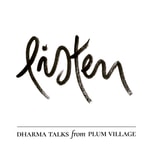Thich Nhat Hanh Dharma Talks – Details, episodes & analysis
Podcast details
Technical and general information from the podcast's RSS feed.

Thich Nhat Hanh Dharma Talks
Kenley Neufeld
Frequency: 1 episode/11d. Total Eps: 298

Recent rankings
Latest chart positions across Apple Podcasts and Spotify rankings.
Apple Podcasts
🇨🇦 Canada - buddhism
05/08/2025#11🇬🇧 Great Britain - buddhism
05/08/2025#6🇬🇧 Great Britain - religionAndSpirituality
05/08/2025#99🇩🇪 Germany - buddhism
05/08/2025#16🇺🇸 USA - buddhism
05/08/2025#11🇫🇷 France - buddhism
05/08/2025#23🇨🇦 Canada - buddhism
04/08/2025#9🇬🇧 Great Britain - buddhism
04/08/2025#8🇩🇪 Germany - buddhism
04/08/2025#23🇺🇸 USA - buddhism
04/08/2025#13
Spotify
No recent rankings available
Shared links between episodes and podcasts
Links found in episode descriptions and other podcasts that share them.
See all- https://plumvillage.org/support
12 shares
RSS feed quality and score
Technical evaluation of the podcast's RSS feed quality and structure.
See allScore global : 48%
Publication history
Monthly episode publishing history over the past years.
Live Happily in the Present Moment
dimanche 7 février 2021 • Duration 11:27
How do we Practice as a Sangha
jeudi 21 janvier 2021 • Duration 01:17:10
Chronic Depression and Medications
dimanche 8 mars 2020 • Duration 08:45
The Cake in the Refrigerator
mercredi 23 juillet 2014 • Duration 01:14:11
I Have Arrived. I am Home.
dimanche 20 juillet 2014 • Duration 47:56
What is Happiness?
mercredi 16 juillet 2014 • Duration 01:29:41
Our Appointment with Life
vendredi 11 juillet 2014 • Duration 37:17
Stepping into Freedom
jeudi 3 juillet 2014 • Duration 01:09:45
How to Promote World Peace
vendredi 20 juin 2014 • Duration 01:46:30
Exploring the Joy of Practice
dimanche 15 juin 2014 • Duration 01:56:44

